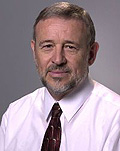Nanomedicine – How Can Something so Small be so Huge for the Future of Healthcare?
Category
Published on
Abstract
Dr. James Leary discusses the future on medicine and the impact nanotechnology will have on healthcare.
Bio
 Professor Leary has an S.B degree in aerospace engineering from M.I.T and a Ph.D. in Biophysics from Penn State University. After faculty positions at the University of Rochester Medical School and the University of Texas Medical Branch in Galveston, he moved to Purdue on July 1, 2005 and became the SVM (School of Veterinary Medicine) Endowed Professor of Nanomedicine and a tenured full professor in the Department of Basic Medical Sciences and the Weldon School of Biomedical Engineering. Recently he was elected a Fellow of the AIMBE (American Institute for Medical and Biological Engineering), the highest honorary for biomedical engineers in the United States, for his pioneering work in the invention of high-speed flow cytometry and rare-event analysis as well as his more recent work in the design of bionanomedical systems and portable BioMEMS devices.
Professor Leary has an S.B degree in aerospace engineering from M.I.T and a Ph.D. in Biophysics from Penn State University. After faculty positions at the University of Rochester Medical School and the University of Texas Medical Branch in Galveston, he moved to Purdue on July 1, 2005 and became the SVM (School of Veterinary Medicine) Endowed Professor of Nanomedicine and a tenured full professor in the Department of Basic Medical Sciences and the Weldon School of Biomedical Engineering. Recently he was elected a Fellow of the AIMBE (American Institute for Medical and Biological Engineering), the highest honorary for biomedical engineers in the United States, for his pioneering work in the invention of high-speed flow cytometry and rare-event analysis as well as his more recent work in the design of bionanomedical systems and portable BioMEMS devices. Sponsored by
2010 USA Biology Olympiad hosted by Purdue University.
Cite this work
Researchers should cite this work as follows:
Time
Location
Burton Morgan 121, Purdue University, West Lafayette, IN